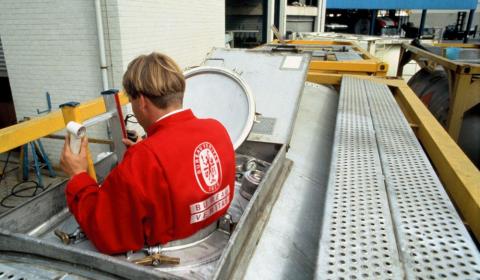
THE CHANGING WORLD OF WORKPLACE HEALTH & SAFETY
Over the last ten years, the world of work has changed dramatically. Digital tools and increased connectivity have enabled flexible working conditions for office employees. At the same time, automation, robotics and artificial intelligence have partly automated many tasks for employees on the shop floor. These profound changes to the ways in which we work have a direct impact on occupational health and safety. Bureau Veritas offers unrivaled expertise in health and safety management systems such as ISO 45001, which enable organizations to address the risks of workplace health and safety in the digital era.
Flexible working conditions: not for everyone?
Offering flexible working arrangements has become an appealing solution for companies looking to help their employees achieve a better work-life balance. In fact, 67% of employees wish they were offered flexible working.1 And it’s not hard to see why: employees with flexible working conditions report being better able to meet family and personal needs, control their schedules and working environment and reduce commuting time.2 For employers, offering flexible working arrangements enables them to benefit from increased employee morale, while reducing absenteeism and turnover.2
However, a recent study3 warns that flexible working conditions can also have an adverse effect on some employees. This is because flexible working conditions often make it difficult to establish a clear divide between home and work, thus fostering an “always on” culture that can take a heavy psychological toll.3 Other downsides of flexible working conditions can be physical, such as the risk of back pain or repetitive strain injury from long hours in front of a computer, sitting on a chair not designed for that purpose.
To support employees with flexible working conditions in improving their workplace well-being and combatting poor working conditions at home, companies can turn to occupational health and safety management systems (OH&SMS) such as ISO 45001. This leading international OH&SMS standard was updated in 2018 to redefine “workers” and “workplace” to be more inclusive of any person performing work or work-related activities in a place where work is performed—not just at the office.
Automation: from increased productivity to greater worker burn-out
Today, automation technologies are developing at an unprecedented rate. For companies, robotics, artificial intelligence and other automation technologies bring the promise of higher productivity, increased efficiency, safety and convenience. It is estimated that 60% of all occupations have at least 30% of activities that can be automated with existing technology.4
But while automation can be used to improve working conditions by freeing workers from non-value-added tasks, it can also negatively impact occupational health and safety. According to a recent study,5 the downsides of automation include the following:
- Work intensification: Because workers feel forced to adapt to a production model based on machine performance, this can result in accidents and illness. It can also cause worker burn-out and labor market exclusion.
- Increased job insecurity: For employees working in occupations with a high risk of automation, increased job insecurity is often reported. This instability is linked to higher stress levels, and thus, poorer overall health.
Current occupational health and safety standards are beginning to account for increased automation in the workplace, as well as the introduction of robots. In fact, ISO 45001 recently added a technical specification that addresses the safety considerations involved in instituting automation.
Increased employee stress in our digital world
Digitalization and new technologies—such as artificial intelligence, bionics, wearable technology, virtual reality, big data, 3D and 4D printing—are transforming the nature of jobs and the ways in which we perform tasks. Digitally controlled, remotely operated machinery is replacing manual operator control equipment. And millions of connected devices are expected to join the industrial internet of things by 2020.6 Experts believe that, by 2025, these technologies will profoundly transform the equipment, tools and systems we use to organize, manage and provide products and services.
A recent report7 identified several risks to occupational safety and health as a result of digitalization.While many positive outcomes are anticipated—such as less exposure to traditionally hazardous environments thanks to robotics and automation, a variety of psychosocial and organizational factors are very likely to raise employee stress levels. These factors include the following:
- Increased worker monitoring
- Assumption of 24/7 availability
- More frequent job changes
- Increased ergonomic risks caused by human-machine interfaces
Occupational health and safety strategies can help to address some of these challenges. For example, adoption of the ISO 45001 standard involvesthe use of workplace assessments to identify risk areas. In addition, ISO 45001 can help define a worker-centered approach when planning and implementing digitalization strategies. It can also provide a valuable framework to clarify occupational health and safety liabilities and responsibilities that relate to working styles.
Bureau Veritas: a leader in ISO 45001 certification
Bureau Veritas is a Business to Business to Society company, committed to contributing experience and expertise in health and safety in pursuit of a better world. Bureau Veritas was among the first certification bodies to gain accreditation by UKAS to ISO 45001, a standard that enables clients to meet their workplace health and safety needs, and to improve the productivity and performance of their organizations. Bureau Veritas offers a range of certification and training services relating to ISO 45001. Our training programs have been developed for all learning styles and are taught by our expert OH&S Lead Auditors.
1 https://www.powwownow.co.uk/smarter-working/flexible-working-statistics-2017
2 https://www.thebalancecareers.com/advantages-and-disadvantages-of-flexible-work-schedules-1917964
3 https://www.sciencedaily.com/releases/2018/08/180810091553.htm
4 https://www.mckinsey.com/featured-insights/employment-and-growth/technology-jobs-and-the-future-of-work
5 https://www.greeneuropeanjournal.eu/will-technology-improve-health-and-safety-at-work
6 https://www.travelers.com/business-insights/topics/equipment/impact-of-emerging-technology-on-equipment
7 https://osha.europa.eu/en/about-eu-osha/press-room/working-digital-future-new-study-anticipates-safety-and-health-risks-lie